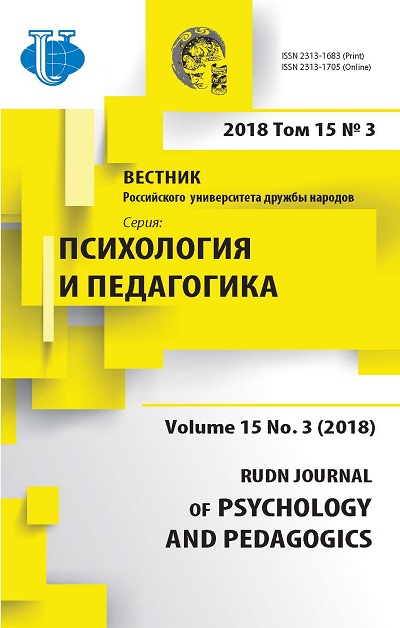CONTENT CHARACTERISTICS OF THE “SUBJECT FIELD” OF DISCRIMINATORY ATTITUDES
- Authors: Bocharova E.E1
-
Affiliations:
- Saratov State University
- Issue: Vol 15, No 3 (2018)
- Pages: 308-322
- Section: PERSONALITY AND SOCIAL PSYCHOLOGY
- URL: https://journals.rudn.ru/psychology-pedagogics/article/view/19464
- DOI: https://doi.org/10.22363/2313-1683-2018-15-3-308-322
Cite item
Full Text
Abstract
The aim of the research presented in the article is the theoretical and empirical study of the content of the subject field of discriminatory attitudes. The study is based on the sample ( N = 168), the average age is 27.63 years, the sample is predominantly female (78.6%). The following approaches were used in the study: “Scale of basic beliefs” by R. Janoff-Bullman adapted by M.A. Padun and A.V. Kotelnikova (Padun, Kotelnikova, 2008); the characteristics of the discriminatory attitudes and attributes were collected using a specifically developed questionnaire. The ratio of the expressiveness of the fundamental beliefs was analysed in the study. It generally indicates the subjects’ beliefs in the benevolence of the surrounding world, in the value of their own Self against the background of doubting the world’s justice and the ability to control life events. The fact of the situational manifestation of the discriminatory attitudes is recorded. The content characteristics of the discriminatory attributes of the cross-group discrimination are established, including “ Unusual behaviour ”, “ That he/she does something worse than I do ”, “ That he/she does something better than I do ”, the content of which is described as “ Danger to people ”, “ He/she does everything badly ”, “ Disingenuity ” (respectively). The content characteristics of “the subject field” of discriminatory attitudes are identified including the unusual behaviour of the Others different from the generally accepted social norms, the supremacy of “my group”, adherence to a different culture or subculture. A significant “contribution” to the content of discriminatory attitudes - the fundamental belief “conviction of the need for control” - has been revealed in relation to the “unusual behaviour” described by the subjects as socially dangerous. The applied aspect of the investigated problem can be realized in the development of the preventive programs to reduce the risk of discriminatory behavior.
About the authors
Elena E Bocharova
Saratov State University
Author for correspondence.
Email: bocharova-e@mail.ru
Ph.D. in Psychology, Associate Professor, Associate Professor of the Department Social Educational and Developmental Psychology at Saratov State University
83, Astrakhanskaya str., Saratov, 410012, Russian FederationReferences
- Agadullina, E.R., & Kotova, M.V. (2010). Minimal group paradigm: history of creation and contemporary development. Psikhologicheskie issledovaniya, 6 (14). URL: http://psystudy.ru doi: 0421000116/0055. (Accessed: 13 May 2018) (In Russ.).
- Al Ramiah, A., Hewstone, M., Dovidio, J.F., & Penner, L.A. (2010). The social psychology of discrimination: theory, measurement and consequences. The Social Psychology of Discrimination (pp. 84—112). New York.
- Bocharova, E.E. (2014). Personal Ethnic and Civil Identity in Representatives of Various Ethnic Groups. Izvestiya of Saratov University. New Series. Series: Educational Acmeology. Developmental Psychology, 3(3), 203—291. (In Russ.).
- Dontsov, А.I, Perelygina, E.B., & Karavayeva, L.P. (2014). Intercultural interaction and social distance. National Psychological Journal, 2(14), 5—12. doi: 10.11621/npj.2014.0201 (In Russ.).
- Dubovskaya, E.M. (2014). Transitive society as a factor of personality socialization. Psikhologicheskie issledovaniya, (7), 36. URL: http://psystudy.ru. doi: 0421000116/0055. (Accessed: 13 May 2018) (In Russ.).
- Epstein, S. (1991). The self-concept, the traumatic neurosis, and the structure of personality. In R. Hogan (Ed.), Perspectives in Personality, 3A, 63—98.
- Janoff-Bulman, R. (1989). Assumptive worlds and the stress of traumatic events: Application of schema construct. Social Cognition, 7, 13—136.
- Kleinpenning, G., & Hagendoorn, L. (1993). Forms of racism and the cumulative dimension of ethnic attitudes. Social Psychology Quarterly, 56(1), 21—36.
- Martsinkovskaya, T.D. (2015). Modern psychology — challenges of transitivity. Psikhologicheskie issledovaniya, (8), 42. URL: http://psystudy.ru. (Accessed: 13 May 2018) (In Russ.).
- Padun, M.A., & Kotel’nikova, A.V. (2008). Personal basic beliefs research method of R. Janoff-Bulman. Psikhologicheskii Zhurnal, 29(4), 98—106. (In Russ.).
- Padun, M.A., & Kotel’nikova, A.V. (2012). Psikhicheskaya travma i kartina mira. Teoriya, empiriya, praktika. Moscow: Institut psikhologii RAN Publ. 206 p. (In Russ.).
- Perry, B.L., Harp, K.L., & Oser, C.B. (2013). Racial and gender discrimination in the stress process: Implications for African American women’s health and well-being. Sociological Perspectives, 56(1), 25—48.
- Pettigrew, T. (2003). People under threat: Americans, Arabs and Israelis. Journal of Peace Psychology, 9(1), 69—90.
- Processy identifikacii rossijskih grazhdan v social’nom prostranstve “svoih” i “nesvoih” grupp i soobwestv (2004). 1999—2002: Master-klass professora V.A. Yadova (pp. 61—62). Moscow.: Aspekt press. (In Russ.).
- Ryaguzova, E.V. (2011). Social’naya psihologiya lichnostnyh reprezentaciy vzaimodejstvijya “JA — Drugoy”. Saratov: Nauchnaya kniga Publ. 304 p. (In Russ.).
- Ryaguzova, E.V. (2016). Socio-Cultural Matrix of Personality Development. Izvestiya of Saratov University. New Series. Series: Educational Acmeology. Developmental Psychology, 5(1). 34—39. doi: 10.18500/2304-9790-2016-5-1 -34-39 (In Russ.)
- Tikhonova, A.D., Dvoryanchikov, N.V., Ernst-Vintila, A., & Bovina I.B. (2017). Radicalisation of Adolescents and Youth: In Search of Explanations. Кul’turno-istoricheskaya psikhologiya = Culturalhistorical psychology, 13 (3), 32—40. doi: 10.17759/chp.2017130305 (In Russ.).
- Ulybina, E.V., Lensment, A., & Ahmet, I. (2009) Attitude of the Ethnic Minority to the Ethnic Majority: Situational and Dispositional Factors. Psychology. Journal of the Higer Scool of Economics, 6(4), 94—102. (In Russ.)
- Shamionov, R.M. (2018). Formation of Discriminatory Personal Attitudes in the Process of Socialization. Izvestiya of Saratov University. New Series. Series: Educational Acmeology. Developmental Psychology, 7(2), 129—135. doi: 10.18500/2304-9790-2018-7-2-129-132 (In Russ.).
- Shipilov, A.V. (2008). “His”, “strangers” and others. Moscow: Progress Publ. 257 p. (In Russ.)
- Shihirev, P.N. (1993). Mezhnacional’nye otnosheniya kak ob’ekt social’no-psihologicheskogo issledovaniya. In P.N. Shihirev (Ed.), Social’no-psihologicheskie issledovaniya mezhnacional’nyh otnoshenij (pp. 9—10). Moscow: Institut psihologii RAN Publ. (In Russ.)
- Taylor, D.M., Wright, S.C., Moghaddam, E.M., & Lalonde, R.N. (1990). The personal/group discrepancy: Perceiving my group but not myself, to be a target of discrimination. Personality and Social Psychology Bulletin, 16, 254—262.
- Yilmaz, I., Koca, F., & Celik, A. (2017). Investigation of the role of parent attitudes, SES and religiosity in university students’ discriminative attitudes. Journal of Human Sciences, 14(4), 3626—3633. doi: 10.14687/jhs.v14i4.4762
















